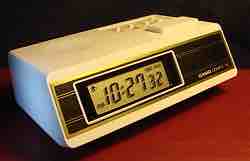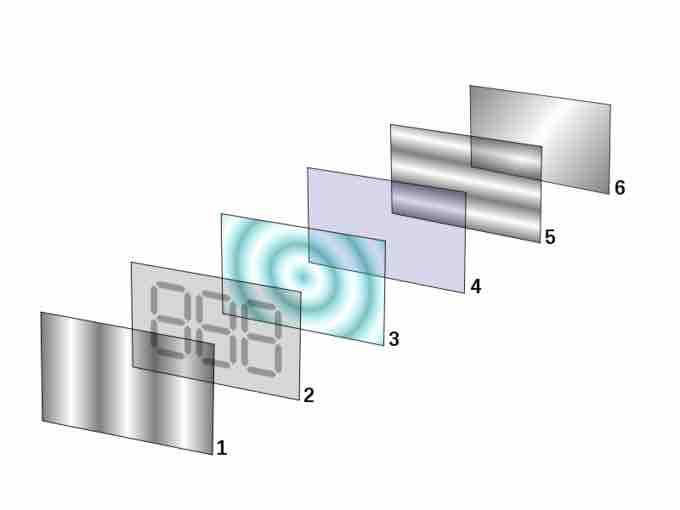LCDs
LCD stands for a liquid crystal display. The liquid crystals themselves do not emit light, but the display uses the light modulating properties of the crystals. LCDs can be used to display arbitrary images, such as in a computer monitor or television, by using a large number of very small pixels, or they can be used to display fixed images, like a digital clock, such as in .

Digital Clock
A digital clock which uses LCD to either hide or display fixed images.
Unlike the newer cathode ray tube (CRT) and plasma displays, LCDS do not use phosphors. For this reason they do not suffer image burn-in. They do however suffer image persistence. Image burn-in occurs when an image is displayed so many times, or for so long, that an outline of image can be seen even when the display is turned off. Image persistence is similar, but the outline fades away shortly after the display is turned off and is not permanent.
LCD displays are made up of numerous layers. A typical layer is diagrammed in . Each pixel of an LCD consists of a layer of molecules aligned between two transparent electrodes and two polarizing films, and the actual liquid crystals are between these polarizing filters. The light passes through the first filter, and is blocked by the second. The electrodes are used to align the crystals in a particular direction, which produces the image seen on the screen. The crystals do not emit any light, but rather give the light a specific shape to be emitted in.

Layers of LCD Displays
Polarizing filter film with a vertical axis to polarize light as it enters.Glass substrate with ITO electrodes. The shapes of these electrodes will determine the shapes that will appear when the LCD is turned on. Vertical ridges etched on the surface are smooth.Twisted nematic liquid crystal.Glass substrate with common electrode film (ITO) with horizontal ridges to line up with the horizontal filter.Polarizing filter film with a horizontal axis to block/pass light.Reflective surface to send light back to viewer. (In a backlit LCD, this layer is replaced with a light source. )
Twisted Nematic Devices
The twisted nematic device is the most common LCD application. When no electric field is being applied, the surface alignment directions at the electrodes are perpendicular to each other. The molecules arrange themselves in a helical structure (twisted structure). Some light is able to pass through and some is not, so the result is that the screen appears gray. When the electric field is applied, the crystals in the center layer untwist, and the light is completely blocked from passing through and those pixels will appear black.